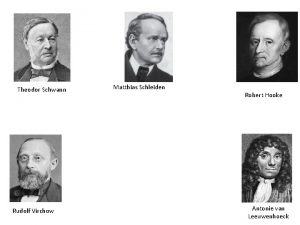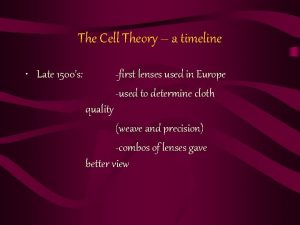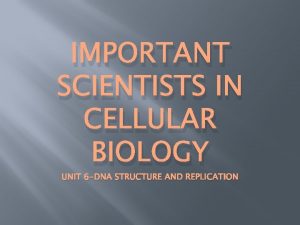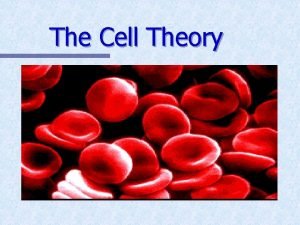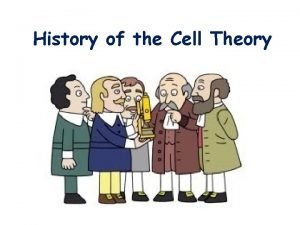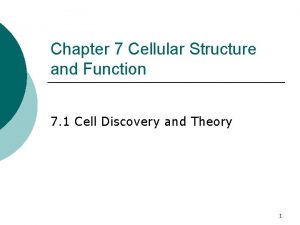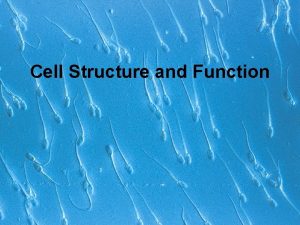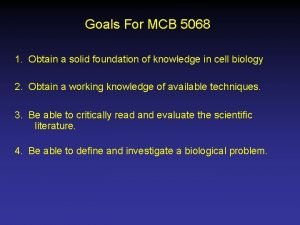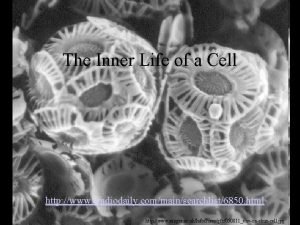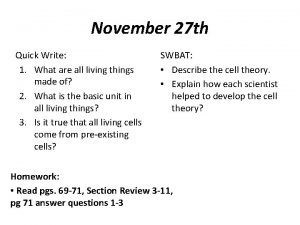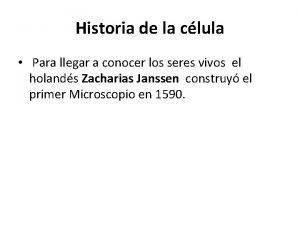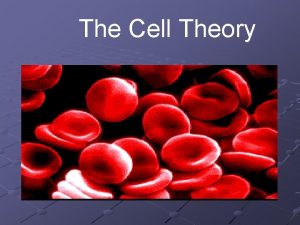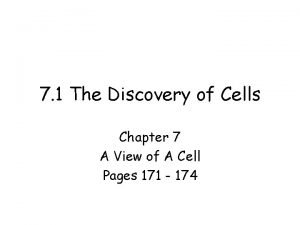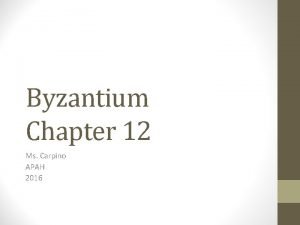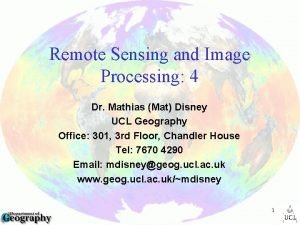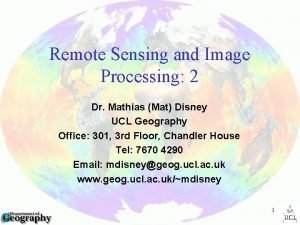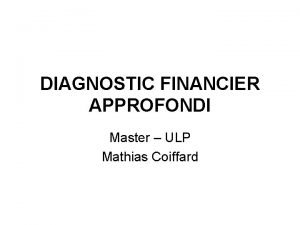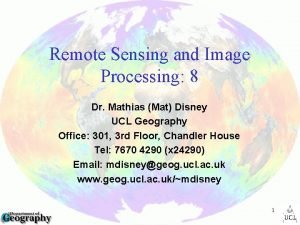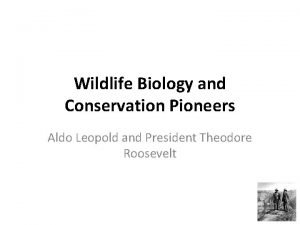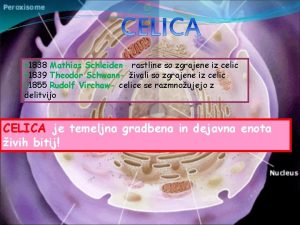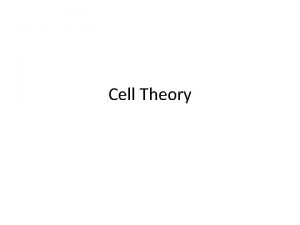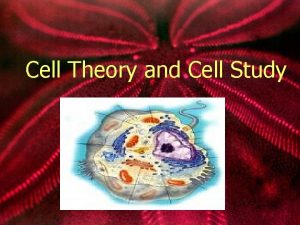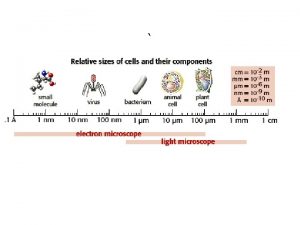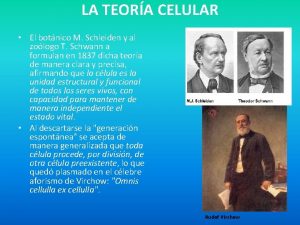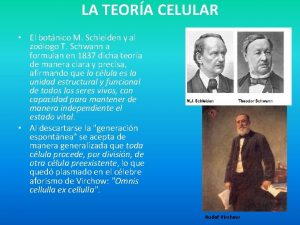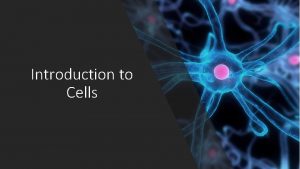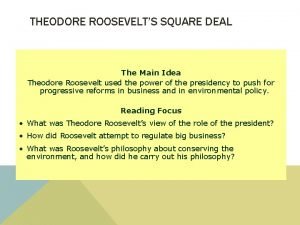Cell Architecture CELL THEORY Mathias Schleiden and Theodore




































- Slides: 36

Cell Architecture

CELL THEORY • Mathias Schleiden and Theodore Schwann • Prokaryotic cell • Eukaryotic cell – plant cell and animal cell • Figure 9 -1

Animal cell substructures

Single and Double Membrane Substructures • Single Membrane Structures – Plasma Membrane – Endoplasmic Reticulum – Golgi Apparatus – Lysosome – Peroxisome – Endosome • Double membrane structures – Nucleus and Mitochondria

Plant Cell Substructures

Single and Double Membrane Substructures • Single Membrane Structures – Plasma Membrane – Endoplasmic Reticulum – Golgi Apparatus – Lysosome – Peroxisome – Endosome • Double membrane structures – Nucleus and Chloroplast

Plasma Membrane Chapter 10 Fig. 10 -1

EM OF A THIN ERYTHROCYTE MEMBRANE

How do endosomes work?

Lysosomes • Internal compartment is very different form the cytosol –more acidic p. H • Degrades substances that are obsolete • Phagocytosis and Endocytosis • All lysosmal enzymes are acid hydrolases • Tays Sach’s disease – defect in enzyme catalyzing a step in the lysosomal breakdown of gangliosides.

Autophagy


Plant Vacuoles • Similar to lysosomes – degradative enzymes • Concentration of solutes is larger inside the vacuole than outside • Stores small molecules and is permeable to water • Elongation of the plant is related to water uptake by the vacuole

EM OF A PLANT CELL

Peroxisomes • 0. 2 -1. 0 micrometer in diameter • Oxidases • Catalase 2 H₂O₂ -----> 2 H₂O + O₂ • Main site of fatty acid peroxidation • Various toxic molecules that enter the body are degraded here

Mitochondrial vs. Peroxisomal Oxidation Fig. 12 -12

Endoplasmic Reticulum • Smooth ER: – Synthesis of Fatty Acids and Lipids – Metabolism of Carbohydrates – Detoxify Drugs and Poisons • Rough ER: – Synthesis of Secretory Proteins, Membrane and Organelle Proteins

ROUGH ER IS MADE OF RIBOSOMES

RIBOSOMES • Composed of r. RNA and protein • Site of protein synthesis • Proteins are marked for different organelles or for secretion • Ribosomes are assembled in the nucleolus • Free Ribosomes

PROTEIN MODIFICATION IN THE ER SECRETED PROTIENS – GLYCOSYLATION – DISULFIDE BOND FORMATION

HORMONE SECRETING CELL FROM RAT PITUITARY

Golgi Apparatus

Golgi - Function • Flattened membrane vesicles or sacs • Cis, medial and trans -Golgi • Proteins targeted for different points in the cell are modified differently • Secretory proteins • Plasma membrane proteins • Membrane or soluble proteins to other organelles

HOW SECRETORY PROTEINS ARE TRANSPORTED?

ORGANELLES WITH DOUBLE MEMBRANES • MITOCHONDRIA – Power house of the cell – Site of cellular respiration – Organic molecules are used fro ATP synthesis NUCLEUS contains chromosomes, DNA and RNA CHLOROPLAST Site of Photosynthesis

EM OF A MITOCHONDRION

STRUCTURE OF A MITOCHONDRION

OUTER MEMBRANE AND INNER MEMBRANE • OUTER MEMBRANE – 50% lipid and 50% protein – Porin proteins (MW of 10, 000) INNER MEMBRANE - CRISTAE

POWER HOUSE OF THE CELL

Nucleus • Inner membrane and outer membrane • Outer membrane is continuous with rough ER • The intermembrane space is continuous with the lumen of the ER • Nuclear pores and nucleoporins • Heterochromatin • Ribosomal RNA assembly


HETEROCHROMATIN

CHLOROPLAST • • • Double membraned organelle Length is 10µm and thickness of 0. 5 -2 µm Sacs - Thylakoids Stacks are grana Matrix space called Stroma Photosynthesis

MITOCHONDRIA AND CHLOROPLAST • • ATP production Move around in the cell Contain their own DNA Some of their proteins are encoded in the nucleus

EM OF A PLANT CHLOROPLAST

 Matthias schleiden e theodor schwann
Matthias schleiden e theodor schwann Chapter 4 cell theory and cell study
Chapter 4 cell theory and cell study Matthias schleiden timeline
Matthias schleiden timeline Matthias schleiden cell theory contribution
Matthias schleiden cell theory contribution Facts about schleiden
Facts about schleiden Robert hook cell theory
Robert hook cell theory Matthias schleiden
Matthias schleiden Matthias schleiden
Matthias schleiden Matthias jakob schleiden
Matthias jakob schleiden Nucle
Nucle Inner life of a cell
Inner life of a cell Matthius schleiden
Matthius schleiden Matthias schleiden 1838
Matthias schleiden 1838 Matthias schleiden facts
Matthias schleiden facts Anton van leeuwenhoek accomplishments
Anton van leeuwenhoek accomplishments Saint apollinaris amid sheep
Saint apollinaris amid sheep Seminari montfort malang
Seminari montfort malang Mathias temot
Mathias temot Mathias fünfstück
Mathias fünfstück Mathias temot
Mathias temot Mathias loris
Mathias loris Somatiseringstilstand
Somatiseringstilstand Mathias reinecke
Mathias reinecke Mathias fabich
Mathias fabich Mathias bienstman
Mathias bienstman Mathias coiffard
Mathias coiffard Lms
Lms Mathias loris
Mathias loris Mathias reinecke
Mathias reinecke Mathias temot
Mathias temot Jordvarmebekendtgørelsen
Jordvarmebekendtgørelsen Mathias lux
Mathias lux Mathias jourdan
Mathias jourdan Mathias thaler
Mathias thaler Fraunhofer moez
Fraunhofer moez Aldo leopold and theodore roosevelt
Aldo leopold and theodore roosevelt Theodore roosevelt college and career academy
Theodore roosevelt college and career academy
